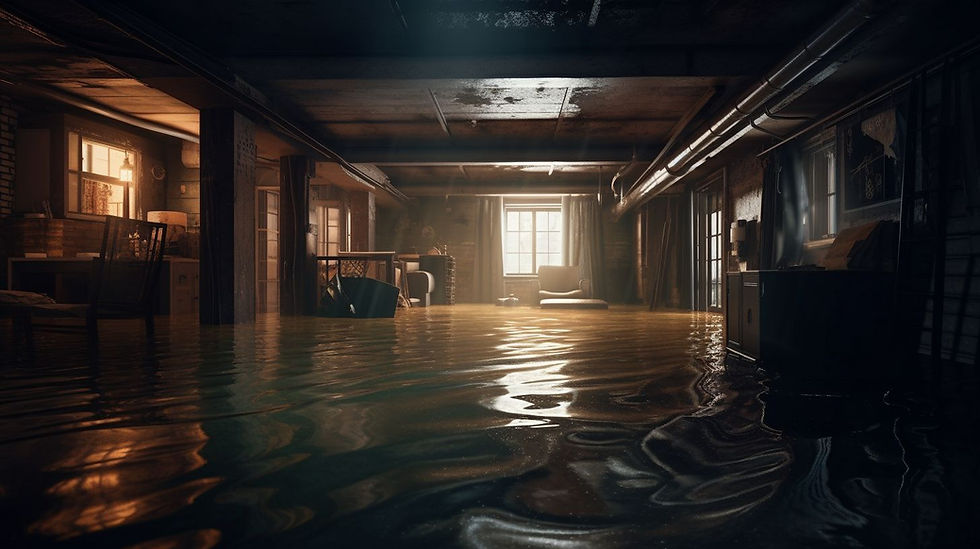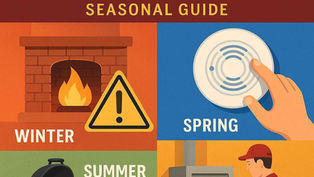5 Common Causes of Water Damage in Homes and How to Prevent Them
- Relief Restorations
- Dec 5, 2024
- 10 min read
Updated: Dec 13, 2024

Introduction
Water damage is one of the most significant threats to a home’s structural integrity and long-term value. Even a small leak can quickly escalate, compromising walls, ceilings, flooring, and personal belongings. Left unaddressed, water damage can lead to costly repairs, weaken the foundation of the home, and create an environment conducive to mould and mildew growth.
Beyond the structural impact, water damage also poses health risks. Mould, which thrives in damp conditions, can cause respiratory issues, allergies, and other health complications, particularly for vulnerable individuals. Additionally, water damage can lead to pest infestations, electrical hazards, and decreased indoor air quality.
Early detection and prevention are critical in minimizing these risks. By identifying and addressing potential issues before they become major problems, homeowners can save money, protect their property, and ensure a safe living environment. Routine inspections, timely maintenance, and proper water management systems are essential strategies in safeguarding your home from water damage.
Common Causes of Water Damage in Homes
Cause 1: Leaking or Burst Pipes
Leaking or burst pipes are a leading cause of water damage in homes, often resulting from a combination of environmental and structural factors. Understanding these causes can help homeowners take proactive steps to prevent costly repairs and water damage.
Common Reasons for Pipe Leaks:
Freezing Temperatures: In colder climates, water inside pipes can freeze and expand, causing the pipes to crack or burst. This is especially common in uninsulated areas like basements, crawl spaces, and exterior walls.
Corrosion: Over time, pipes made from materials like galvanized steel or copper can corrode due to chemical reactions with water and minerals. Corroded pipes become weak and are prone to leaks.
High Water Pressure: Excessively high water pressure can place undue stress on pipes, fittings, and joints, increasing the likelihood of leaks or bursts. Pipes are designed to handle a certain range of pressure, and exceeding this limit can lead to failure.
Prevention Tips:
Insulate Pipes: In colder regions, such as Winnipeg and other parts of Manitoba, insulating pipes exposed to cooler temperatures is crucial. Use pipe insulation sleeves or heat tape to protect pipes in unheated areas. This helps prevent freezing during harsh winters.
Regular Inspections: Conduct routine checks of your home’s plumbing system, especially in areas prone to moisture, such as basements and under sinks. Look for signs of corrosion, rust, or small leaks that could escalate if left unaddressed.
Monitor Water Pressure: Use a water pressure gauge to ensure your home’s pressure stays within the recommended range (typically 40 to 60 psi). If the pressure is too high, install a pressure regulator to protect your plumbing system from damage.
Taking these preventive measures can significantly reduce the risk of leaking or burst pipes, helping homeowners avoid the headaches and expenses associated with water damage.
Cause 2: Faulty or Aging Roofing
A home’s roof is its first line of defense against rain, snow, and other weather elements. However, as roofs age or sustain damage, they can become vulnerable to water intrusion. Even minor issues, if left unchecked, can lead to significant water damage inside the home.
How Roof Damage Can Lead to Water Intrusion:
Missing or Damaged Shingles: Shingles act as a protective barrier, directing water off the roof. When shingles are missing, cracked, or curled, water can seep through the exposed areas, damaging the underlying roof structure.
Clogged Gutters and Downspouts: Gutters and downspouts are designed to channel water away from the roof and foundation. When they become clogged with leaves, debris, or ice, water can pool on the roof, increasing the risk of leaks and water damage.
Cracked or Worn Flashing: Flashing, which seals roof joints and edges around vents and chimneys, can deteriorate over time. If the flashing is compromised, water can penetrate these vulnerable areas.
Prevention Tips:
Schedule Regular Roof Inspections: Have a professional inspect your roof at least once a year, or after severe weather events. Inspections can identify and address potential issues before they escalate.
Clean Gutters and Downspouts: Clear out gutters and downspouts regularly, especially in the fall when leaves accumulate. Proper drainage prevents water from pooling and finding its way into the home.
Repair Damaged Shingles or Flashing Immediately: Promptly replace any missing or damaged shingles and repair cracked or loose flashing. Even small repairs can make a big difference in preventing water intrusion.
By maintaining a healthy roof and ensuring proper drainage, homeowners can significantly reduce the risk of water damage caused by faulty or aging roofing. Proactive care not only extends the life of the roof but also protects the entire home from costly repairs.
Cause 3: Poorly Sealed Windows and Doors
Windows and doors are key entry points for natural light and ventilation, but if not properly sealed, they can also become pathways for water intrusion. Even small gaps or cracks around these areas can allow rainwater to seep into your home, leading to damage over time. Water entry through poorly sealed windows and doors can cause issues such as warped frames, peeling paint, and even mould growth if left unchecked.
How Gaps and Cracks Allow Water Entry:
Compromised Seals and Weather Stripping: Over time, the seals around windows and doors can deteriorate due to exposure to weather and temperature fluctuations. When these seals fail, water can infiltrate during heavy rains or wind-driven storms.
Unsealed Gaps and Cracks: Small cracks in window frames or door thresholds may seem insignificant but can allow water to trickle inside, especially during prolonged exposure to rain.
Poor Drainage Around the Foundation: Improper grading or clogged drainage systems can cause water to pool near windows and doors at ground level, increasing the risk of seepage.
Prevention Tips:
Inspect Seals and Weather Stripping Annually: Check the seals and weather stripping around windows and doors at least once a year. Look for signs of wear, cracking, or detachment. Replace any damaged components to maintain a tight seal.
Use Caulking to Fill Gaps: Apply waterproof caulking to fill any gaps or cracks around window frames and door thresholds. This creates a barrier that prevents water from entering. For added protection, consider installing storm windows, particularly in areas prone to harsh weather.
Ensure Proper Drainage Around the Foundation: Make sure that the ground slopes away from your home’s foundation to direct water away. Clean out any clogged drainage systems or install new ones if necessary to prevent water from pooling near windows and doors.
Taking these steps can help homeowners prevent water damage caused by poorly sealed windows and doors. Regular maintenance and proper drainage are essential for keeping water out and preserving the integrity of your home’s interior.
Cause 4: Appliance Malfunctions
Household appliances play a vital role in daily life, but they can also be a significant source of water damage when they malfunction. Appliances that use water, such as washing machines, dishwashers, and water heaters, are especially prone to leaks and failures that can lead to extensive damage if not promptly addressed. A minor issue, like a loose hose or worn-out connection, can quickly escalate into a costly repair if water spreads unchecked.
Appliances That Commonly Cause Water Damage:
Washing Machines: Hoses and connections are particularly vulnerable to wear and tear, especially if the machine vibrates during use. A burst hose can release a large amount of water in a short time.
Dishwashers: Leaks can occur when seals or gaskets fail, or when the appliance isn’t draining properly. Water can seep out onto the kitchen floor, potentially damaging cabinets and flooring.
Water Heaters: Water heaters can develop leaks over time due to corrosion or pressure buildup. A sudden failure can release significant amounts of water, often in basements or utility rooms.
Prevention Tips:
Regularly Inspect Hoses and Connections: Check the hoses and connections on your appliances for signs of wear, cracks, or leaks. Pay special attention to the areas where hoses connect to the appliance and the wall.
Replace Old Hoses with Stainless Steel Braided Versions: Rubber hoses are more prone to cracking and bursting over time. Replacing them with stainless steel braided hoses provides greater durability and reduces the risk of failure.
Schedule Routine Maintenance: Keep your appliances in good working condition by following the manufacturer’s maintenance guidelines. Regular servicing can help identify potential issues before they lead to water damage.
By staying vigilant and maintaining your appliances, you can significantly reduce the risk of water damage in your home. Small, proactive measures can save you from the headaches and expenses of dealing with a major appliance failure.
Cause 5: Basement Water Intrusion
Basements are particularly susceptible to water damage due to their location below ground level. Water intrusion in basements can cause significant structural damage, ruin personal belongings, and create a breeding ground for mould. Understanding the common causes of basement flooding is key to preventing these issues.
Causes of Basement Flooding:
Poor Drainage: Inefficient drainage systems, such as clogged or improperly installed gutters and downspouts, can lead to water pooling around the foundation. Over time, this water can seep into the basement.
Foundation Cracks: Even small cracks in the foundation can allow water to enter, especially during heavy rains or when snow melts. These cracks often develop due to natural settling or shifts in the soil.
Sump Pump Failure: A sump pump is designed to remove water from the basement, but if it fails—due to power outages, mechanical issues, or lack of maintenance—water can quickly accumulate, leading to flooding.
Prevention Tips:
Install and Maintain a Sump Pump with a Backup System: Ensure your sump pump is in good working order and consider installing a battery or water-powered backup system. This ensures the pump continues to operate during power outages or mechanical failures.
Ensure Proper Grading and Drainage Around the Home: The ground around your home should slope away from the foundation to direct water away. Additionally, keep gutters and downspouts clean and ensure they extend far enough to prevent water from pooling near the foundation.
Seal Foundation Cracks and Install a Waterproof Membrane: Inspect your basement walls and foundation for cracks and seal them with appropriate materials. For added protection, consider applying a waterproof membrane to the exterior of the foundation to prevent water infiltration.
By addressing these common causes of basement water intrusion, homeowners can protect their basements from flooding and minimize the risk of water damage. Preventive measures not only safeguard your property but also contribute to a healthier and more comfortable living environment.
Additional Tips for Water Damage Prevention
In addition to addressing specific causes of water damage, general home maintenance and proactive measures can significantly reduce the risk of water-related issues. By staying vigilant and prepared, homeowners can minimize the impact of unexpected water damage events.
1. Importance of Regular Home Maintenance and Inspections
Routine maintenance is essential for identifying potential problems before they escalate. Small issues, such as a minor leak or a worn seal, can often be fixed easily if caught early.
Inspect plumbing, roofing, and drainage systems regularly to spot signs of wear, damage, or blockages.
Pay attention to areas prone to moisture, such as basements, bathrooms, and around appliances.
Schedule professional inspections for systems like roofing and HVAC to ensure they remain in good condition.
2. Installing Water Leak Detection Systems
Water leak detection systems can provide an early warning of leaks, helping to prevent extensive damage. These systems are particularly useful in high-risk areas, such as basements, kitchens, and around appliances.
Smart leak detectors can send alerts to your phone, allowing you to take immediate action even if you’re not home.
Some systems can be integrated with smart home technology, automatically shutting off the water supply if a leak is detected.
3. Knowing How to Shut Off the Main Water Supply
In the event of a major leak or burst pipe, knowing how to quickly shut off the main water supply can prevent extensive damage.
Locate the main water shut-off valve, typically found near the water meter or where the main water line enters the home.
Ensure all household members know how to access and operate the shut-off valve.
Consider labeling the valve and providing a simple set of instructions for quick reference in emergencies.
By incorporating these additional preventive measures, homeowners can create a comprehensive defense against water damage. Regular maintenance, modern technology, and preparedness can make all the difference in protecting your home and avoiding costly repairs.
Conclusion
Water damage can cause significant issues in any home, from structural deterioration to health risks associated with mould growth. Understanding the key causes—such as leaking or burst pipes, faulty roofing, poorly sealed windows and doors, appliance malfunctions, and basement water intrusion—is the first step in protecting your property. Each of these risks can be mitigated with simple, proactive strategies like regular inspections, proper maintenance, and prompt repairs.
Taking preventive measures, such as insulating pipes, sealing foundation cracks, maintaining appliances, and ensuring proper drainage, can save homeowners from costly repairs and potential hazards. Additionally, installing water leak detection systems and knowing how to shut off the main water supply are invaluable steps in managing emergencies.
Ultimately, proactive care is the best defense against water damage. While many preventive tasks can be done by homeowners, it’s crucial to consult professionals for thorough inspections and repairs. Experts can identify hidden risks and provide solutions tailored to your home’s specific needs, ensuring long-term protection and peace of mind.
Contact Relief Restorations Today – Schedule a moisture survey, inspection or consultation with our team to ensure your home is protected. Let us help you safeguard your home and restore peace of mind, knowing that you’re in good hands.
Our Testing, Inspection, and Services Include:
· Inspections & Consultations
· Mould Air Testing with Third Party Lab Results and Recommendations
· Moisture Surveys
· Mould Inspections
· Fogging
· Mould Prevention
· Mould Remediation
· Water Damage Restoration
· Asbestos Remediation
· Light Demolition
· & More
We Want to Hear From You!
Have you ever dealt with water damage? What steps did you take to prevent future water damage? Share your experience in the comments below—your insights could help others.
If you found this post helpful, don't forget to share it with your friends and family to spread the word about water damage prevention.
Stay Informed - Subscribe
Subscribe to our blog and newsletter at the top or bottom of this page for tips, information, exclusive offers, and more expert advice on property maintenance, mould prevention, and other restoration, remediation and health tips to keep your home or property safe and healthy.
About Relief Restorations
At Relief Restorations, we specialize in providing comprehensive mould remediation, water damage restoration, asbestos removal, light demolition, inspection and testing services across Winnipeg and Manitoba, Canada.
With a focus on safety and quality, our expert team is dedicated to restoring your property and ensuring a healthier living environment. Whether you're a homeowner, business, tenant, landlord, or property manager, you can trust us to handle any restoration or remediation challenge with professionalism and care. Contact us today to learn more about how we can help protect your property.
Please note: The information on this post and website are for educational purposes only and does not replace professional inspection or remediation services or offer legal or medical advice.



















Comments